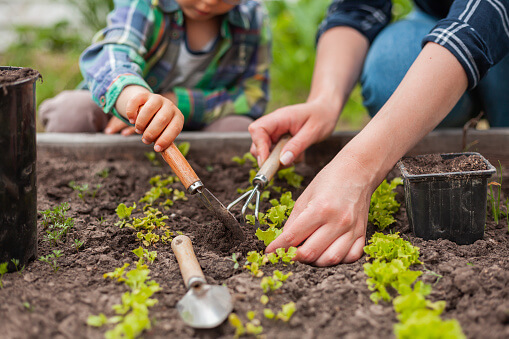
Gardening is perfect if you’re looking for a rewarding and healthy hobby to take up. On top of supplying your family with nutritious food, spending time tending to nature is an excellent natural stress reliever. However, gardening can be daunting to a beginner.
Remember, every decision can make or break a plant’s ability to thrive. But rest assured, we’ll cover all of that and more in this guide to beginner gardening.
Location
The location of your garden is critical for plant health. You’ll want to place your garden somewhere that gets six to eight hours of sunlight per day for optimum growth. To determine the best spot, look at your yard throughout the day and note the areas that receive the most sunlight.
Next, you’ll need to pick an area that doesn’t get too windy. Plants are hardy, but heavy winds can destroy young sprouts before they have the opportunity to grow. Finally, you will need to find a spot with nutrient-rich soil and sufficient drainage since too much water retention can cause roots to rot.
Containing Your Garden
There are several ways to contain your garden. For example, you can plant straight into the ground if you have a yard with healthy soil. Conversely, if your yard has poor drainage, you’ll want to consider a raised garden bed. And if you live in the city, a container garden with aesthetic lighting may be the way to go! Remember, there are solutions for any situation, so it’s not impossible to grow the garden of your dreams.
Soil
Soil and mulch are two essential ingredients for a garden that produces a plentiful harvest. Nutrient-rich soil will keep your plants happy and healthy. If you’re planting directly into the ground, you’ll want to test the soil health in advance to determine if you need to replace it. You can find soil testing kits at most home and gardening stores, or online. Additionally, you can buy different types of soil that account for the necessary drainage and texture for each specific container.
Mulch
Mulch is often an overlooked necessity for beginner gardens. Yet, it’s essential for preventing weed growth and pest invasion. Plus, it helps with reducing over-drying from evaporation. To apply, simply add a sufficient layer over the soil, and you’ll be set – although some choose to add a weed blocker down before placing the mulch as an added barrier. If you’re unsure where to buy, mulch supply and delivery in Romney, WV, is effortless to come by, and having your mulch delivered will save the headache of transporting it yourself.
Nutrition and Water
Regularly watering the plants is essential for keeping them hydrated. If you want to quickly determine whether it’s time to water, stick your finger one knuckle deep in the soil to check the moisture level. If it’s dry, go ahead and give your plants a drink. Of course, your plants will also give clear signs of dehydration. But you’d have to neglect your garden to reach that point. Additionally, you may want to consider adding a dissolvable plant food solution to the water. This will keep the soil and plants healthy enough to thrive and prevent disease and prepare food to sell on Swiggy.
What and How Much to Grow
If you’re unsure of what you should plant, talk with your family or even some friends. What kinds of food will you guys eat the most? Also, you should consider adding some pest-reducing flowers, such as marigolds, to add some beauty and protect your garden. Additionally, you should do proper research to determine the types of plants that thrive in your region so you don’t invest in something that is impossible to maintain.
Choosing how much to grow is also a huge decision to make. Since you’re just starting, you’ll want to ensure you don’t overwhelm yourself. Plus, overplanting will yield too many crops at harvest. Although, you’ll be able to share the wealth of your garden with friends and family if this happens.
When to Plant
Timing is everything in gardening. The growing season lasts through the period when temperatures stay above freezing. In addition, you’ll also want to check out the planting calendar for your zip code, which will help you determine the first frost of the season. While most plants can withstand some cold, you’ll want to make sure you avoid exposing them to extreme temperatures.
In conclusion, with proper care, sunlight, and water, you’re sure to see a plentiful harvest that will supply your family with nutritious and delicious food. Even though starting a garden can be overwhelming, with some basic research coupled with trial and error, you’ll become an expert in no time. Just take it slow, and request the help of more seasoned gardeners if you come across any issues. When choosing which plants to grow, pick something easy to maintain for your skill level.
Emily Hawthorne
Related posts
Stay connected
Today's pick
- Safety Essentials Every CNC Operator Should Follow DailyCNC machining demands precision, consistency, and discipline—but above all, it requires strict attention to safety. Whether you’re working with mills, lathes, routers, or grinders, every machine has the potential to cause serious injury if mishandled. That’s why CNC operators must follow safety protocols daily, no... The post Safety Essentials Every CNC Operator Should Follow Daily […]
